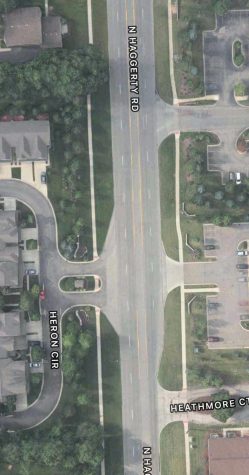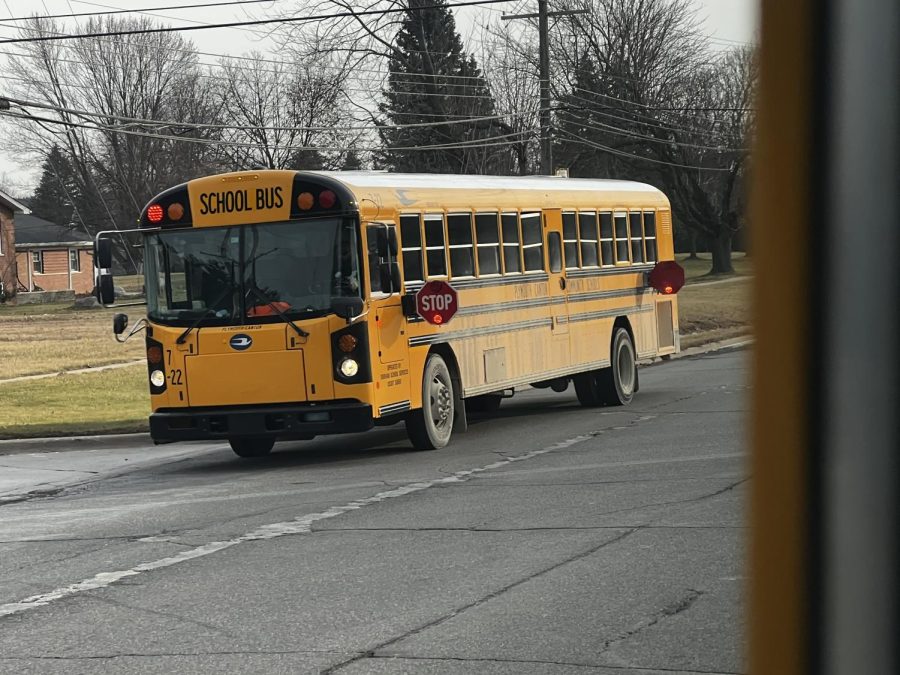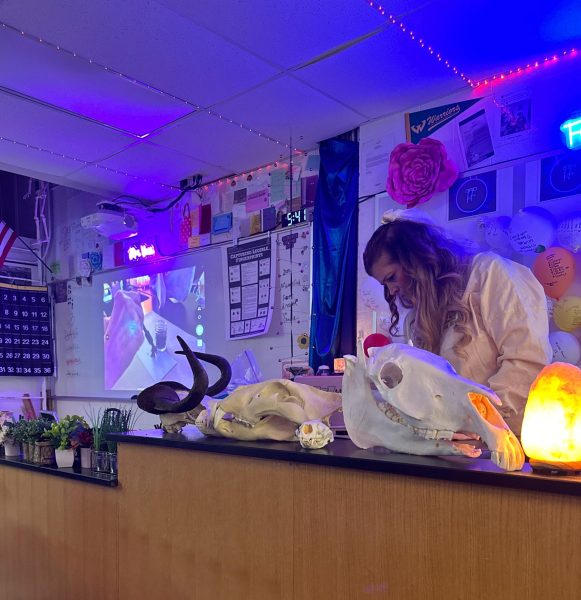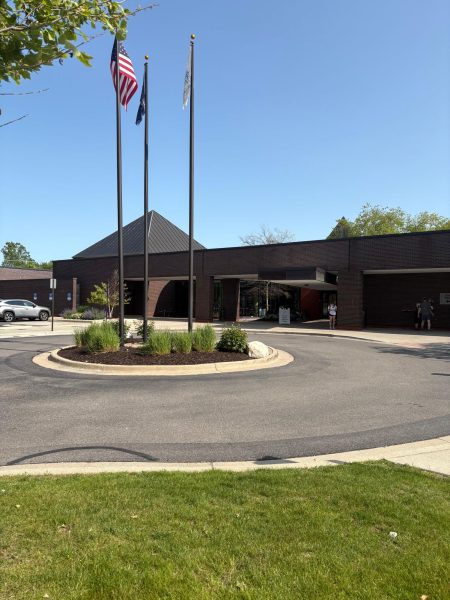Passing a school bus with activated signals: Drivers in personal vehicles take risks with students’ lives using unsafe practices near buses
Plymouth-Canton Community Schools bus drops off students on Haggerty Road with its stop-arms and flashing lights activated. December 21, 2022.

School bus transportation has become increasingly dangerous for bus drivers and for student passengers in the state of Michigan. Drivers passing school buses with activated signals has become more frequent.
According to upnorthlive.com, an ABC News website, Michigan law enforcement issued 50 citations for drivers illegally passing school buses out of the 122 traffic stops that occurred over the course of five days, October 18-22, 2021.
In a May 2019 survey reported in UpNorthLive, 1,373 bus drivers found that motorists passed a school bus illegally 508 times.
Students on buses have witnessed drivers passing buses while the lights are flashing. “We had a car earlier that didn’t stop,” said Chloe Ferguson, a student at Johannesburg-Lewiston High School, a school in a district near Gaylord, Michigan. “[The rate of illegal passing has] increased this year. I’ve never heard my old bus driver honk at a car, but my bus driver now does it quite a bit.”
Under Michigan law, drivers must prepare to stop when a slowing bus activates its yellow flashing lights, and must stop at least 20 feet away from buses by the time the bus activates its flashing red lights. Failure to abide may result in a fine of up to $500, up to 100 hours of community service and/or three points against the driver’s record.
Section 257.682 of the Michigan Legislature states that stopped drivers may not go “until the school bus resumes motion or the visual signals are no longer actuated.” The code additionally states that “a school bus may be equipped with a stop-arm camera system,” which, if requested by law enforcement, the “video or photograph recorded by” the camera must be provided.
“Buses can have exterior cameras, but we don’t,” said Debby Rodriguez, a school bus driver for Plymouth-Canton Community Schools, “None of our buses do. We need them, but we don’t have them.”
Rodriguez stated that cars and trucks pass her bus all the time, especially on Haggerty Road, where three of her high school stops are.
“I’ve requested our dispatch to have police presence [at those three stops] multiple times, but I never see any, and people still go right past my lights at those stops,” said Rodriguez. “Even box trucks drive right through my stops, sometimes semis will come by, too.”
Haggerty Road, which runs from West Bloomfield Township down to Van Buren Charter Township, often sees heavy daytime traffic flow, and large trucks use the road frequently as I-275 runs parallel to nearby Haggerty Road. Occasionally, school buses transport students who have to cross the road to get to and from their stop. Therefore, when vehicles illegally pass by bus signals, students may be in the path of a car and can potentially be hit.
A section on Safe Routes to School (SRTS) titled “Determining School Bus Stop Locations” states policies that some districts have about where bus stops should be located. The website states that districts should try to place bus stops where most or all students should not have to cross a road, and, if crossing a road cannot be avoided, there should be traffic control devices “to provide assistance to pedestrians crossing,” and to avoid a student having to walk on major roads that are congested or have high speeds.
“I only have to cross a small street in my neighborhood, and Debby always waits with her lights on until I do,” said Patrick Warner, Canton sophomore and passenger on Rodriguez’s bus. “I don’t really feel unsafe walking home from my stop, but I think if I had to cross Haggerty or something like that, I would definitely consider having my dad or someone drive me home, although neither of my parents can do that.”

Warner said that he sees around five to 10 cars pass the bus at the Haggerty stops. The portion of Haggerty the bus drives on is a single lane, but at the school bus stops, the road widens so cars have a turn lane into a neighborhood. The formation of the street allows room for the bus to pull out of the main lane of traffic when it makes the stop, but the maneuver also allows other vehicles room to pass the bus even though they should not.
“There should be more advertising or message spread about the issue, because it isn’t talked about very much,” said Lilly Townsend, Salem sophomore. “Maybe [the school district] could put some signs [on the roads] that say ‘Stop for Buses’ or something like that.”
The Plymouth-Canton buses do not have any signs on their rear that tell drivers to stop when the lights are flashing.
The Michigan Pupil Transportation Act section 257.1812, last amended in 2006, states school buses “may be equipped with” an electronic sign that displays warning messages, such as “stop,” “do not pass,” “stopping,” and other words and phrases described in the section, but does not require signage.
Section 257.1809 reads, “The state board or its authorized representative may review, confirm, set aside, or amend the action, order, or decision of a school with reference to the routes over which pupils shall be transported…”. ” The section also states the superintendent of public instruction, Dr. Micheal F. Rice, or the department of state police with cooperation with the superintendent, shall promulgate, or put a law into effect by official proclamation, “rules related to vehicle and equipment standards.”

Your donation will support the student journalists of Salem High School - MI. Your contribution will allow us to purchase equipment and cover our annual website hosting costs.

Teddy Morin is a Canton junior who unexpectedly took a passion for writing after discovering his love for writing country song lyrics and fictional stories....












